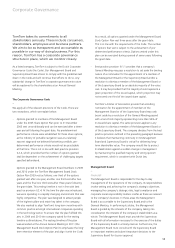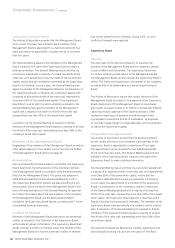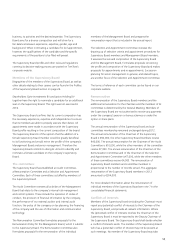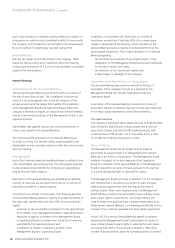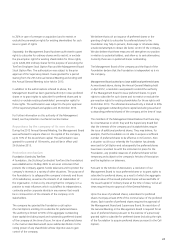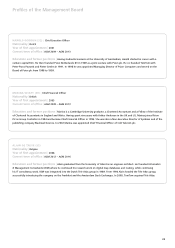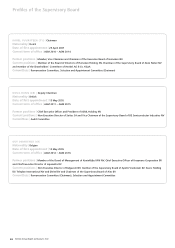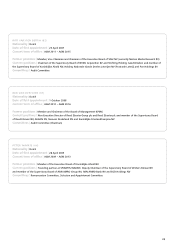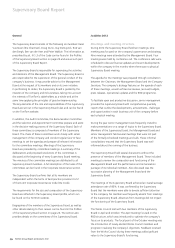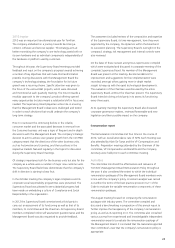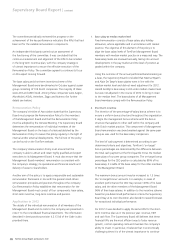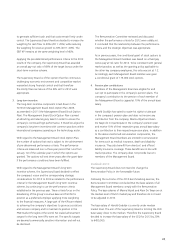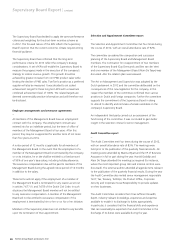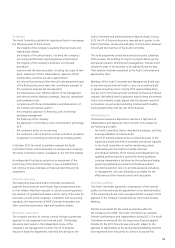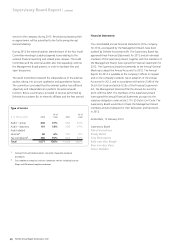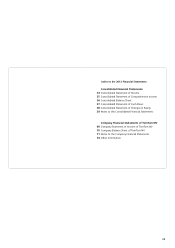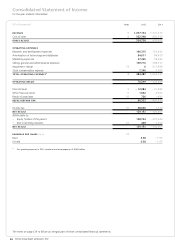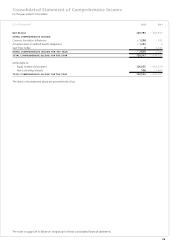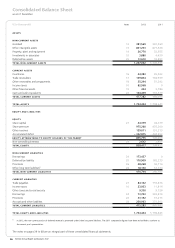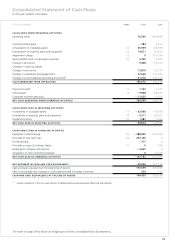TomTom 2012 Annual Report Download - page 29
Download and view the complete annual report
Please find page 29 of the 2012 TomTom annual report below. You can navigate through the pages in the report by either clicking on the pages listed below, or by using the keyword search tool below to find specific information within the annual report.27
The assessment included reviews of the composition and expertise
of the Supervisory Board, its time management, how they were
supported by the company, the dynamics within the board and
its succession planning. The Supervisory Board’s oversight on the
company’s strategy, risk management and internal controls were
also reviewed.
On the basis of these reviews anonymous reports were compiled
which were evaluated and discussed in a separate meeting of the
complete Supervisory Board. No member of the Management
Board was present at this meeting. Recommendations for
improvement and suggestions for their implementation were
recorded; amongst others gaining more in-depth market
insight to keep up with the rapid technological developments.
The evaluation of the Chairman was discussed by the entire
Supervisory Board, without the Chairman present. The Supervisory
Board intends to bring a third party in to assess its functioning
every three years.
At its quarterly meetings the Supervisory Board also discussed
corporate governance matters, reviewed foreseeable and new
legislation and their possible impact on the company.
Remuneration report
—
The Remuneration Committee met four times in the course of
2012, with an overall attendance rate of 92%. Each meeting was
also attended by Alain De Taeye and the VP Compensation and
Benefi ts. Preparation meetings attended by the Chairman of the
committee, VP Compensation and Benefi ts and the Company
Secretary were held prior to each committee meeting.
Activities
The committee monitored the effectiveness and relevance of
TomTom’s Management Board Remuneration Policy throughout
the year. It also considered the extent to which the individual
remuneration packages of the Management Board members were
in line with the company’s policy. A scenario analysis was carried
out within the terms of the best practice provision II.2.1 of the
Code to evaluate the variable remuneration components of these
remuneration packages.
The August meeting focused on comparing the remuneration
packages with industry peers. The committee compiled and
discussed a benchmarking in preparation of this annual report to
further improve the transparency of the company’s remuneration
policy, as well as its reporting on it. The committee also consulted
various surveys from experienced and knowledgeable independent
remuneration experts to evaluate the remuneration package of
the Management Board. It concluded that the materials supported
their committee’s view that the company’s remuneration policy is
appropriate.
2012 topics
2012 was an important transformational year for TomTom.
The company embarked on a journey towards becoming a
content, software and services supplier. This strategy aims at
better monetising the company’s core technology assets both on
its own hardware and as individual components independently of
the hardware or platform used by customers.
Throughout this year, the Supervisory Board meetings provided
feedback and input on the company’s progress towards achieving
a number of key objectives that will make this transformation
possible. During discussions with the Management Board the
company’s technology strategy, the foundation for its future
growth was a recurring theme. Specifi c attention was given to
the focus of the various R&D projects, which were discussed
and monitored at each quarterly meeting. The move towards a
modular approach to the company’s product offering opened
many opportunities but also meant a substantial shift in focus was
needed. The Supervisory Board played an active role in ensuring
that the Management Board’s ideas were challenged and tested
in order to reach decisions that would underpin the company’s
long-term strategy.
How to counteract the continuing decline in the volatile,
consumer market and the associated decrease in revenue from
the Consumer business unit was a topic of frequent and in-depth
discussions with the Management Board. The company’s strategic
decision to aim to achieve ever greater growth from the non-PND
category meant that the directions of the other business units,
such as Automotive and Licensing, and their positions in the
respective markets featured regularly in the topics for discussion
during the Supervisory Board meetings.
Of strategic importance both for the business units but also for the
company as a whole were a number of major new customer wins.
The Supervisory Board feels these demonstrate that the company’s
shift in direction is starting to bear fruit.
In the October meeting the company’s legal compliance and its
corporate social responsibility programmes were presented. The
Supervisory Board was pleased to see substantial progress had
been made on embedding a culture of Compliance and Social
Responsibility in the organisation.
In 2012 the Supervisory Board commissioned a third party to
carry out an assessment of its functioning as well as that of its
members, its committees and the Chairman. All Supervisory Board
members completed online self-assessment questionnaires and the
Management Board was also requested to provide feedback.


